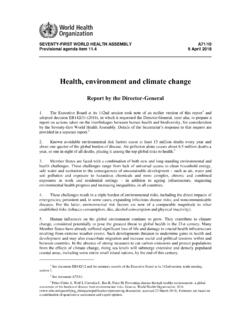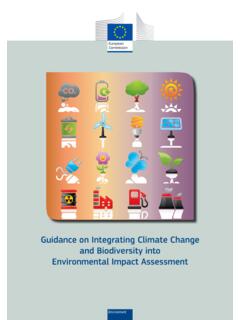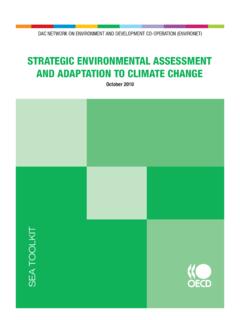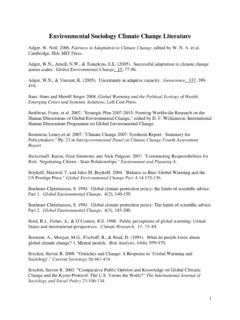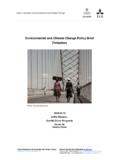Transcription of Assessing the Impact of Climate Change on Migration and ...
1 Assessing the Impact of Climate Change on Migration and Conflict Clionadh Raleigh, Lisa Jordan and Idean Salehyan This paper has been commissioned by the World Bank Group for the "Social Dimensions of Climate Change " workshop. Views represented are those of the authors, and do not represent an official position of the World Bank Group or those of the Executive Directors of the World Bank or the overnments they represent. The World Bank does not guarantee the accuracy of data presented in gthis paper. of this paper, please contact: For additional copiest Social DevelopmenThe World Bank 818 H Street, NW 1 Washington, DC 20433 E-mail: Printed on Recycled Paper Assessing the Impact of Climate Change on Migration and Conflict* Clionadh Raleigh University of Essex Centre for the Study of Civil War- International Peace Research Institute Lisa Jordan Florida State University Idean Salehyan University of North Texas *This paper was written under contract 7145451 between PRIO and the World Bank for the program on Exploring the Social Dimensions of Climate Change .
2 The opinions expressed in this document represent the views of the authors and do not necessarily state or reflect those of the World Bank. Contents Executive Summary iv Introduction 1 Changes in the Current Discourse 2 Changing Perspectives on Climate Change Induced Migration 3 A Changing Framework 3 The Impacts and Migration Potential of Select Disasters 5 Droughts and
3 Famines 6 Floods and Slides 6 Cyclones, Hurricanes and Waves 7 Extreme Temperatures 7 Sea Level Rise 7 Estimating Affected Populations and Migrant Potential 8 Table 1: Summary of EM-DAT Statistics by Disaster 9 Table 2: Summary of EM-DAT Disaster Statistics by Region 10 Chart 1: Relative Disaster Frequency 11 Chart 2: Relative Disaster Affect 12 Chart 3: Number and Percentage of Populations Affected by Drought 12 Hotspots and Predictions 13 Map 1: Vulnerability to Floods, Droughts and Wind Storms 14 Map 2.
4 Population Change in High Risk Areas (Flood) 15 Table 3: Areas Highly Vulnerable to Disasters in Near Future 16 Coping with Increased environmental Risks 16 Building Resilience to Degradation, Droughts and Famine 17 Coping with Sudden Onset Disasters 18 Direct and Indirect Environmentally Induced Migration 19 Table 4: Typology of Potential Migrants 20 Internal Migration 20 Distress Migration 22 Local Displacement 23 Seeking Aid 24 Permanent Relocation and Resettlement 25 ii The Effects of Government Policies on environmental Migrants 28 Government Policies Which Influence Vulnerability and Coping 29 Table 5: Government Policies Which Influence Vulnerability And Resilience 30 Government Polices Influencing Labour and Distress Migration 32 Table 6.
5 Government Polices Influencing Labour and Distress Migration Migration and Conflict 34 Linking Migrations to Conflict 34 Conclusions and Future Research 37 Bibliography 41 iii Executive Summary Climate Change is expected to bring about significant changes in Migration patterns throughout the developing world.
6 Increases in the frequency and severity of chronic environmental hazards and sudden onset disasters are projected to alter the typical Migration patterns of communities and entire countries. We examine evidence for such claims and roundly conclude that large scale community relocation due to either chronic or sudden onset hazards is and continues to be an unlikely response. We propose an alternate framework through which to examine the likely consequences of increased hazards. It is built upon the five major conclusions of this paper: First, disasters vary considerably in their potential to instigate Migration . Moreover, individual, community and national vulnerabilities shape responses as much as disaster effects do.
7 Focussing on how people are vulnerable as a function of political, economic and social forces leads to an in-depth understanding of post-disaster human security. Second, individuals and communities in the developing world incorporate environmental risk into their livelihoods. Their ability to do so effectively is contingent upon their available assets. Diversifying income streams is the predominant avenue through which people mitigate increased hazards from Climate changes. Labour Migration to rural and urban areas is a common component of diversified local economies. In lesser developed countries, labour Migration is typically internal, temporary and circular. Third, during periods of chronic environmental degradation, such as increased soil salinization or land degradation, the most common responses by individuals and communities is to intensify labour Migration patterns.
8 By doing so, families increase remittances and lessen immediate burdens to provide. Fourth, with the onset of a sudden disaster or the continued presence of a chronic disaster ( drought or famine), communities engage in distress Migration patterns. The characteristics of distress Migration are quite different within and across countries as they are shaped by the severity and geography of a crisis, the ability of a household to respond, evacuation opportunities, existing and perpetuating vulnerabilities, available relief, and intervening government policies. However, generally communities face three choices in relief: 1) to depend on social networks for relief; 2) to be processed by agencies to access aid iv and investigate possible resettlement options or 3) to relocate to camps for temporary or long term resettlement assistance.
9 The first option is a very common response to disasters. The third option remains understudied but is frequently cited as the most probable response to Sea Level Rise in vulnerable countries. In generally, disaster victim return rates are quite high, although little research has been done on this stage of Migration . Fifth, as environmental Migration is typically internal and short term, the potential for instigating conflict is quite minimal. However, unstable urban and rural demographics are related to higher risks of civil war and low level communal conflicts during periods of environmental stress are common. While it is important to highlight environmental pressures and their association with Migration , the term environmental refugee conflates the idea of disaster victim with refugee and reduces the complexity of real situations.
10 We emphasize the linkage between the economic and political vulnerabilities of households and communities with the extent of migrations practiced. We consider how governments and external organizations affected those migrations, and design policy matrices to compare policies designed to address environmental Migration . These conclusions should be considered with multiple caveats. First and foremost, we relied heavily on case studies of previous disasters to determine the main points of our framework. These case studies emphasise the differences across groups, locations and disasters, but do not consider the worst case Climate Change scenarios promoted in public discourse.










